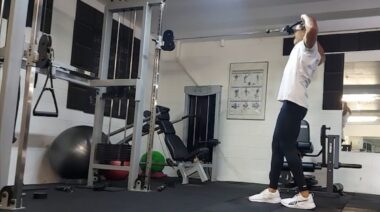The big three areas that keep people from progressing in their training are backs, knees, and shoulders. Unfortunately, most people think that they are all distinctly different issues. But when you understand natural movement and what we are really trying to achieve with functional fitness, you see that they can be very much interconnected.
The big three areas that keep people from progressing in their training are backs, knees, and shoulders. Unfortunately, most people think that they are all distinctly different issues. But when you understand natural movement and what we are really trying to achieve with functional fitness, you see that they can be very much interconnected.
A great example is the innovative work of Thomas Myers. His work is yielding invaluable information about natural movement, and concepts like his “spiral line” are changing how we see training, even with some classic movements. What Mr. Myers shows with the spiral line concept is how interconnected the parts of our bodies are; how our right foot is connected up to our left shoulder through a specific sequence of communication through the body. Without making things complicated, it means that your shoulder, back, or knee problem may be the result, not the cause of the problem.
Understanding such information allows us to target very specific drills to solve a lot of issues at once. A lot of common ailments can be addressed by one of my favorite kettlebell drills, the windmill. The windmill probably isn’t new to you, but I want to change your perception of the potential of this movement.
Windmills Connect the Spiral Line
Before we delve too deep, let’s clarify some misconceptions about the windmill.
- The benefit doesn’t come from “stretching” the shoulder.
- The windmill isn’t a yoga triangle.
The windmill is so much more than a mobility drill. Properly performed, it will build functional strength. I’ll admit it, I used to think the windmill was nothing but a manlier way of approaching flexibility training. But the more I learned about the body, the more appreciation I have gained for the windmill.
One of the reasons I think the windmill is such a powerful drill is because it is one of the few that represents the spiral line that Mr. Myers refers to in his book, Anatomy Trains. If we can build a better connection of the foot, lower leg, hip, trunk, and shoulder, we end up alleviating, or at least greatly reducing many of the problems that plague many of us. Building these strong connections is how we resolve dysfunction, which is often the reason we end up with that fitness goal-killer: pain.
A Hip Hinge for the Frontal Plane
One of the unheralded benefits of the windmill is that it allows us to train the hip hinge pattern in the frontal plane. Our bodies are supposed to move in three dimensions, but most strength programs only focus on one. Expanding our ability to move and be strong in more planes of motion means a greater carryover to life and sport.
Typically, we think of movement training being one thing and strength being another. But the truth is that real functional fitness combines both elements of movement and strength to have a synergistic effect on our bodies. In fact, one study on performance and injury prevention in firefighters showed a greater degree of positive training effects with a movement-based program than a conventional program.1
Most would think of the low windmill as a beginner exercise. Deeper examination shows a variety of benefits resulting from what amounts to a frontal plane deadlift. Challenging what we can do straight up and down and what we can do at varying angles is very different. As Thomas Myers states:
“The fascial system is better trained by a wide variety of vectors—in angle, temp, and load… Loading the tissue one way all the time means it will be weaker when life—which is rarely repetitive—throws that part of the body a curve ball.”
The windmill is a wonderful representation of those ideas and so much more. I have found the three-level approach in the video below to be an effective way to progress the windmill so that you move, feel, perform, and live better.
Can’t get enough kettlebell training?
Make Turkish Get Ups Your Best Movement
Reference:
1. Frost, David M., Tyson AC Beach, Jack P. Callaghan, and Stuart M. McGill. “Exercise-based performance enhancement and injury prevention for firefighters: Contrasting the fitness-and movement-related adaptations to two training methodologies.” The Journal of Strength & Conditioning Research 29, no. 9 (2015): 2441-2459.






